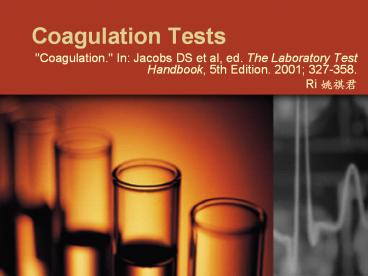Coagulation Tests - PowerPoint PPT Presentation
1 / 23
Title:
Coagulation Tests
Description:
Dilute Russell Viper Venom Time (dRVVT), Anti-Cardiolipin Ab, ACA, IgG, Anti ... Factor I (Fibrinogen), II, V, VII, VWF, VIII, IX, X, Urea solubility test, ... – PowerPoint PPT presentation
Number of Views:3861
Avg rating:3.0/5.0
Title: Coagulation Tests
1
Coagulation Tests
- "Coagulation." In Jacobs DS et al, ed. The
Laboratory Test Handbook, 5th Edition. 2001
327-358. - Ri ???
2
Coagulation Cascade
PT
VIIIa
PTT
Heparin
Hirudin, Argatroban
3
Coagulation and Fibrinolysis
4
Coagulation Tests in NTUH
- Screen test
- Bleeding Time (Duke method, Template method),
Thrombin Time, PT, PTT - Antiphospholipid syndrome
- Dilute Russell Viper Venom Time (dRVVT),
Anti-Cardiolipin Ab, ACA, IgG, Anti-Phospholipid
Ab, APA, IgG, Anti-Cardiolipin Ab, ACA, IgM - Coagulation factor
- Factor I (Fibrinogen), II, V, VII, VWF, VIII,
IX, X, Urea solubility test,
- Other coagulation inhibitor Study, VIII, XI, XII
- DIC profile
- Fibrinogen, FDP, 3P Test, D-dimer
- Fibrinolysis
- Euglobulin clot lysis time, Plasminogen activator
inhibitor, Alpha2-antiplasmin - PLT function
- Platelet aggregation
- Thrombosis
- APC Resistance, Protein S, Antithrombin III,
Protein C, Plasminogen
NTUH portal website
5
Activated Partial Thromboplastin Time (aPTT)
- Clotting time from factor XII to fibrin
clot?intrinsic and common pathways - aPTT? factor deficiency (VIII, IX, XI, XII),
inhibitor (lupus anticoagulant, heparin, hirudin,
or argatroban) - Container blue top (3.2 citrate) tube
6
Activated Partial Thromboplastin Time (aPTT)
- Collection Deliver tubes immediately to the
laboratory - ? factor VIII may degrade?PTT?
- ? platelets release platelet factor 4 (PF4) which
neutralizes heparin ?PTT? - ? from a peripheral vein, avoiding the heparin,
hirudin, or argatroban infusion site
7
Activated Partial Thromboplastin Time (aPTT)
- Causes for Rejection Specimen received more than
4 hours after collection, tubes not filled,
clotted specimens, visible hemolysis - Turnaround Time lt1 day often lt1 hour if
requested stat. The PT and PTT are the most
readily available coagulation tests.
8
Activated Partial Thromboplastin Time (aPTT)
- Reference Interval 20-25 to 32-39 seconds.
Prolong in newborns. Up to 55 seconds at birth,
and gradually decreases into the adult normal
range by the age of 6 months. However, newborns
and infants do not normally experience bleeding,
because a balance between procoagulants and
natural anticoagulants is maintained. - Critical Values gt100-150 seconds
9
Activated Partial Thromboplastin Time (aPTT)
- Limitations
- ? single factor deficiency, below 15 to 45
before the PTT prolongs - ? more sensitive to intrinsic pathway factor
deficiency than to common pathway factor
deficiency - ? very high doses of heparin (cardiac bypass
surgery) activated coagulation time (ACT) instead
10
Activated Partial Thromboplastin Time (aPTT)
- Methodology
- ? reagent (phospholipid with an activator such as
silica, celite, kaolin, ellagic acid) and calcium
are added - ? measure clot formation time
- ? partial phospholipid without tissue factor
11
Prothrombin Time (PT)
- Clotting time from factor VII to fibrin
clot?extrinsic and common pathways - PT? fibrinogen or factors II, V, VII, or X
deficiency, therapeutic anticoagulants (heparin,
hirudin, or argatroban) - Container Blue top (3.2 sodium citrate) tube
12
Prothrombin Time (PT)
- Collection heparin prolongs the PT to a lesser
extent than PTT. Hirudin and argatroban prolong
the PT and PTT. - ? directly from a peripheral vein, avoiding the
heparin, hirudin or argatroban infusion site. - Causes for Rejection Specimen received more than
24 hours after collection, tube not filled,
clotted specimen, visible hemolysis
13
Prothrombin Time (PT)
- Reference Interval 10-12 to 12-14 seconds.
Prolong in newborns. Up to 16 seconds at birth,
and gradually shortens into the adult normal
range by the age of 6 months. - Critical Values gt30 seconds
14
Prothrombin Time (PT)
- Limitations single factor deficiency
- Methodology Reagent called thromboplastin
(phospholipid with tissue factor and calcium)
added, measure clot formation time. - Vitamin K trial may be performed with an
unexplained PT prolongation. If vitamin K
deficiency, the PT becomes normal or
significantly shorter within 12-24 hours after
vitamin K administration.
15
Prothrombin Time (PT)
- Monitoring warfarin international normalized
ratio (INR), therapeutic goal is an INR of 2-3. - ? INR patient PT/normal PTISI
- ? international sensitivity index (ISI), varies
in reagents
16
Effects of Factor Deficiencies on PT and PTT
- PTT Prolonged, PT Normal Deficiencies of factor
VIII, IX, XI, and/or XII (intrinsic pathway) - PT Prolonged, PTT Normal Deficiency of factor
VII (extrinsic pathway), mild-to-moderate
deficiencies of factor II, V, X, and/or
fibrinogen (common pathway) - Both PT and PTT Prolonged Deficiencies of factor
II, V, X, and/or fibrinogen (common pathway),
Multiple factor deficiencies
17
Disseminated Intravascular Coagulation(DIC)
Screen
- D-dimer or fibrin degradation products (FDP),
prothrombin time (PT), activated partial
thromboplastin time (PTT), platelet count, and
fibrinogen. These tests are not specific for DIC. - Specimen Plasma (and whole blood for platelet
count and peripheral blood smear)
18
Disseminated Intravascular Coagulation(DIC) Screen
- Limitation D-dimer and FDP() with physiologic
clot formation, lysis, and liver disease - DIC is a common acquired coagulation disorder
resulting from excessive activation of the
coagulation system, usually due to massive tissue
injury, sepsis, or certain pregnancy
complications.
19
Disseminated Intravascular Coagulation(DIC) Screen
- disseminated microvascular thrombi ?consumes
platelets, coagulation factors, and natural
anticoagulants ?PT, PTT prolongations, bleeding - Reference value FDPlt 5.0 ug/ml, D-Dimerlt324 ug/L
20
D-Dimers and Fibrin Degradation Products (FDP)
- Plasmin degrades fibrin clots into D-dimers and
fibrin degradation products (FDP). - Limitations elevate whenever the coagulation and
fibrinolytic systems are activated. High
rheumatoid factor (RF) levels may cause
false-positive result.
21
Coagulation and Fibrinolysis
22
D-Dimers and Fibrin Degradation Products (FDP)
- Methodology semiquantitative or quantitative
immunoassays - D-dimer is a specific FDP formed only by plasmin
degradation of fibrin, not of intact fibrinogen. - D-Dimer and FDP() DIC or thrombosis (DVT, PE
and MI), liver disease, postoperatively,
significant bleeding, hemodialysis, eclampsia,
sickle cell crisis, cancer, pregnancy
23
Thanks for your attention!































